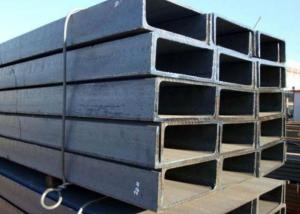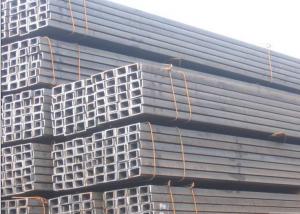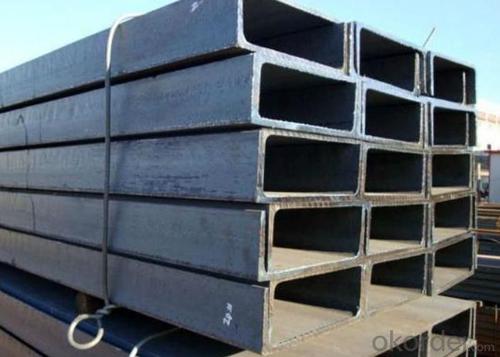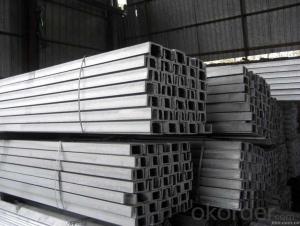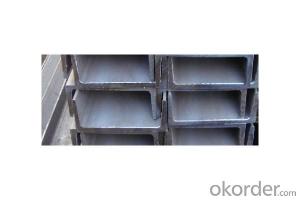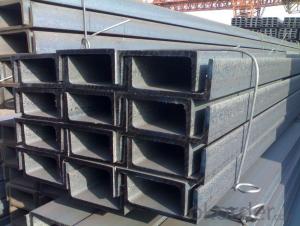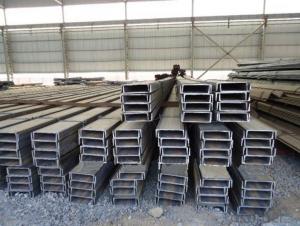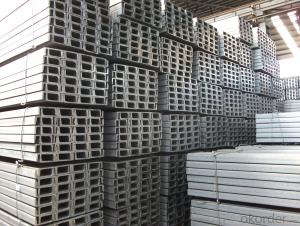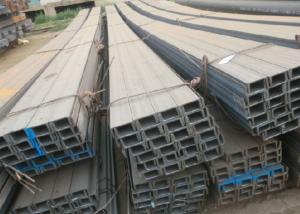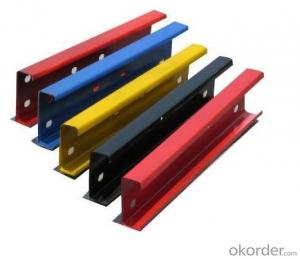Hot Rolled Channel steel
- Loading Port:
- Xingang Port
- Payment Terms:
- TT or LC
- Min Order Qty:
- 25MT m.t.
- Supply Capability:
- 80000-100000MTS/YEAR m.t./month
OKorder Service Pledge
OKorder Financial Service
You Might Also Like
Specifications of Hot Rolled Channel Steel:
1. We are definitely speciallizing in manufacturing and supplying channel steel as per japanese standard, which is characterised with high mechanical strength and competitive prices.
Original Place | Tangshan, China | Brand Name | UINDA |
Standard | JIS G3192 : 1990 | ||
Material Grade | SS540 | ||
Sizes | 50mm to 200mm | ||
Sales Volume/Year | 3000MT | ||
Destination Area | Middle East, Africa, Southeast Asia | ||
2. The sections in details are as followings in the table-1
JIS U CHANNEL | Standard | Sectional | Dimension |
| Mass: |
| (mm) | (mm) | (mm) | (mm) |
|
50x25 | 50 | 25 | 3.0 | 6.00 | 2.37 |
75X40 | 75 | 40 | 3.8 | 7.00 | 5.30 |
75X40 | 75 | 40 | 4.0 | 7.00 | 5.60 |
75X40 | 75 | 40 | 4.5 | 7.00 | 5.85 |
75X40 | 75 | 40 | 5.0 | 7.00 | 6.92 |
|
|
|
|
|
|
100X50 | 100 | 50 | 3.8 | 6.00 | 7.30 |
100X50 | 100 | 50 | 4.2 | 6.00 | 8.03 |
100X50 | 100 | 50 | 4.5 | 7.50 | 8.97 |
100X50 | 100 | 50 | 5.0 | 7.50 | 9.36 |
|
|
|
|
|
|
125X65 | 125 | 65 | 5.2 | 6.80 | 11.66 |
125X65 | 125 | 65 | 5.3 | 6.80 | 12.17 |
125X65 | 125 | 65 | 5.5 | 8.00 | 12.91 |
125X65 | 125 | 65 | 6.0 | 8.00 | 13.40 |
|
|
|
|
|
|
150x75 | 150 | 75 | 5.5 | 7.30 | 14.66 |
150x75 | 150 | 75 | 5.7 | 10.00 | 16.71 |
150x75 | 150 | 75 | 6.0 | 10.00 | 17.90 |
150x75 | 150 | 75 | 6.5 | 10.00 | 18.60 |
150x75 | 150 | 75 | 6.5 | 10.00 | 24.00 |
|
|
|
|
|
|
200X80 | 200 | 80 | 7.5 | 11.00 | 24.60 |
Table-1
3. The mechanical property of Hot Rolled Channel Steel in the table-2:
Grade | Yield Strength,N/mm² | Extension Strength N/mm² | |||
Thickness of Steel,mm | |||||
≦16 | >16-≦40 | >40-≦100 | >100 | ||
SS540 | ≧400 | ≧390 | - | - | ≧540 |
Table-2
4. The chemical composition of Hot Rolled Channel Steel as per SS540 in the table-3
Grade | Yield Strength,N/mm² | Extension Strength N/mm² | |||
Thickness of Steel,mm | |||||
≦16 | >16-≦40 | >40-≦100 | >100 | ||
SS540 | ≧400 | ≧390 | - | - | ≧540 |
Table-3
Usage of Hot Rolled Channel Steel:
1.The Hot Rolled Channel Steel can be devided into two kinds, namely common channel steel and light channel steel. The sizes of hot rolled common channel steel range from 5# to 40#. Meanwhile, the channel steel can be divided into cold forming sectional equal channel steel, cold forming sectional unequal channel steel, cold forming inner edge channel steel and outer edge channel steel.
2.The hot rolled channel steel is usually used for arch-itechtural structure, and they could be welded in order to support or hang a vari-ety of facilities. They are also usually used in combination with I beam. The channel steel with sizes under 14# is usually applied to construction engineering, as purline, while the channel steel with sizes above 16# is more likely to be used in building vehicle chassis structure and mechanical structure. Furthermore, the channel steel in sizes above 30# are target at building bridge structure, as tension bar.
3.In a word, the channel steel must possess perfect welding property, riveting property and mechanical property and so on.
Package & Delivery of Hot Rolled Channel Steel:
1.The hot rolled channel steel will be packed in bundle with steel wire at each end of every bundle and color marking in order to help the customer to recognize his goods more easily at sight.
2. And the channel steel could be loaded into 20ft or 40ft container, or by bulk cargo.If the weight of each bundle reaches more than 3.5 mt, the loading by break bulk cargo should be choosed.When the weight of each bundle reaches less than 3mt, the loading by container should be choosed.
3.As for the transportaion from mill to loading port, the truck will be usually used. And the maximum quantity for each truck is 40mt.
4.All in all, we could do in accordance with customer's request.
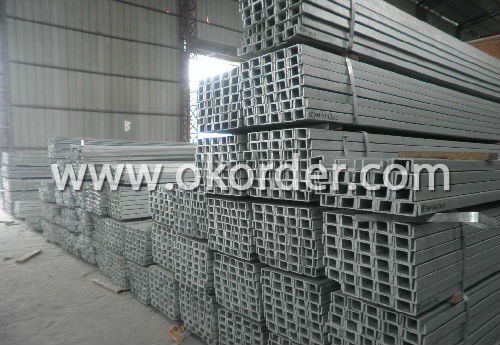
Production Flow of Hot Rolled Channel Steel:
1.The steel billet shall be heated in the high temperature furnace.
2. The heated steel billet shall be rolled five to nine times with the aim of shaping the general figure of steel u channel.
3. The rolled steel u channel should be put onto the cooling bed to make the temperature low.
4. The steel u channel should be straighted on the straightener.
5. The straighted steel u channel will be cut into meters by saw, as per customer's requirements.
6. At the last part of production, the channel steel must be tested in order to confirm that the finished products are completely free from crack, pore, slag, scab or fold on the surface.
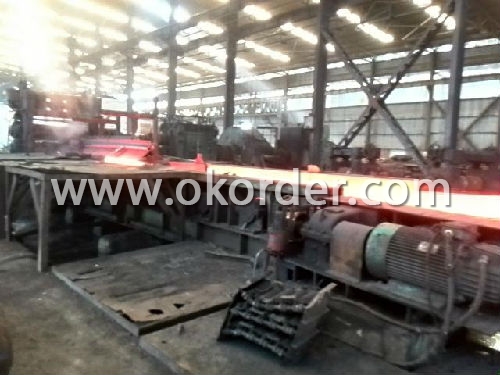
- Q: Channel steel, I-steel, round bar, angle steel, Fang Gang price is per ton to count or by rice? How about tons and meters? The formula is best
- Base area * * 7.85 (7.85 is the specific weight of steel)If the unit of computation is mm, it is "gram""If the unit of work is centimeter, it is "kilogram""If the unit of measurement is rice, it is ton"
- Q: Are steel channels suitable for historical restoration projects?
- Steel channels can certainly be suitable for historical restoration projects, depending on the specific requirements and objectives of the project. Steel channels offer several advantages that make them a popular choice for restoration projects. Firstly, steel channels are known for their durability and strength. They can provide structural support and stability to historical buildings, especially when the original materials are weakened or deteriorated. Steel channels can reinforce weakened walls, floors, or ceilings, ensuring the safety and longevity of the restored structure. Moreover, steel channels can be customized to match the original design and aesthetics of the historical building. They can be shaped and fabricated to replicate the original architectural features, such as decorative moldings or ornamental elements. This allows for a seamless integration of the modern material with the historical structure, preserving its authenticity. Furthermore, steel channels offer versatility in terms of their size and shape, making them suitable for a wide range of restoration projects. They can be used to replace or repair damaged structural elements, such as beams or columns. Steel channels can also be used to create new additions or extensions to historical buildings, while maintaining a harmonious balance between the old and the new. However, it is important to consider the specific guidelines and regulations set by historical preservation organizations or authorities when using steel channels in restoration projects. These guidelines may dictate the use of specific materials or techniques to ensure the preservation of historical authenticity. Therefore, it is crucial to consult with experts in historical restoration and seek necessary approvals before incorporating steel channels into a project. In conclusion, steel channels can be a suitable choice for historical restoration projects, offering durability, flexibility, and the ability to replicate original designs. However, proper consideration of historical preservation guidelines is essential to ensure the integrity and authenticity of the restored structure.
- Q: How do steel channels contribute to the overall structural integrity of a building?
- The utilization of steel channels plays a pivotal role in augmenting the overall structural soundness of a building. These essential structural constituents are frequently employed in construction projects due to their exceptional robustness, endurance, and adaptability. Generally, steel channels are fashioned into C-shaped or U-shaped beams using steel, which confers numerous advantages for the structural stability of a building. Primarily, steel channels proficiently distribute and convey loads. As a result of their configuration, steel channels are adept at supporting heavy loads and evenly dispersing them across multiple points. This equitable allocation of weight obviates the occurrence of concentrated stress points, thereby mitigating the risk of structural failure. Additionally, steel channels possess a high load-bearing capacity, enabling them to endure substantial forces and guarantee the overall steadiness of the building. Secondarily, steel channels offer resistance against bending and torsion forces. Their shape and material composition empower them to resist deformation under pressure, guaranteeing that the building maintains its structural integrity even under extreme conditions such as earthquakes or strong winds. By averting excessive deflection, steel channels aid in maintaining the safety and security of the building. Moreover, steel channels boost the rigidity and stability of the structure. By connecting various components of the building, such as beams, columns, and walls, steel channels effectively eliminate any potential weak points or gaps. This comprehensive integration of different elements contributes to the overall strength and stability of the building, precluding any potential structural failures. Lastly, steel channels provide flexibility in design and construction. They can be easily customized to suit specific architectural requirements, allowing for innovative and efficient building designs. The versatility of steel channels empowers architects and engineers to optimize the strength and stability of the structure while preserving aesthetic appeal. In conclusion, steel channels play a significant role in bolstering the overall structural integrity of a building by efficiently distributing and conveying loads, resisting bending and torsion forces, enhancing rigidity and stability, and providing design flexibility. Their strength, durability, and versatility render them an indispensable component in contemporary construction, ensuring the safety and longevity of buildings.
- Q: Channel steel is mainly used in building structures
- Channel steel is mainly used in building structures, vehicle manufacturing and other industrial structures, and channel steel is often used in conjunction with i-beam. According to the theory of steel structure, it should be stressed by the channel plate, that is to say, the channel should stand rather than lie prone.
- Q: How do steel channels contribute to the overall sustainability of a building?
- Steel channels contribute to the overall sustainability of a building in several ways. Firstly, steel is a highly durable material that has a long lifespan, which means that steel channels used in construction can withstand the test of time. This durability reduces the need for frequent repairs or replacements, thus minimizing the consumption of resources and reducing waste. Furthermore, steel channels have a high strength-to-weight ratio, making them a lightweight yet sturdy option for structural components. This characteristic allows for more efficient construction practices, as less material is required to achieve the same strength and load-bearing capacity. Consequently, the use of steel channels can reduce the overall weight of the building, resulting in lower energy consumption during transportation and construction. Another aspect of steel channels that contributes to sustainability is their recyclability. Steel is one of the most recycled materials in the world, with a high recycling rate. At the end of a building's lifespan, steel channels can be easily dismantled and recycled, preventing them from ending up in landfills. This recycling process saves energy and natural resources that would be required to produce new steel, and it helps to reduce greenhouse gas emissions associated with the production of virgin steel. In addition, the use of steel channels in construction allows for flexibility in design and adaptability in the future. Steel structures can be easily modified or expanded, making them adaptable to changing needs without the need for significant demolition or reconstruction. This adaptability reduces the waste generated during renovations and minimizes the environmental impact of the building throughout its lifecycle. Lastly, steel channels offer excellent fire resistance properties, which enhances the safety and resilience of a building. Steel does not burn, melt, or contribute to the spread of flames, making it a suitable material for fire-resistant construction. By incorporating steel channels in the building's structure, the risk of fire-related damages is reduced, leading to increased safety and reduced environmental impact. In summary, steel channels contribute to the overall sustainability of a building by being durable, lightweight, recyclable, adaptable, and fire-resistant. These characteristics result in the efficient use of resources, lower energy consumption, reduced waste generation, and enhanced safety. Incorporating steel channels in construction not only ensures the longevity of the building but also helps to minimize its environmental footprint.
- Q: Are steel channels suitable for high-rise buildings?
- Yes, steel channels are suitable for high-rise buildings. Steel channels, also known as C-channels or U-channels, are commonly used as structural elements in high-rise construction due to their strength and versatility. Steel channels provide excellent load-bearing capacity and structural stability, making them ideal for supporting the weight of multi-story buildings. They can withstand heavy vertical loads, allowing for efficient vertical load distribution throughout the building. Additionally, steel channels are known for their resistance to bending and torsion, ensuring the structural integrity of high-rise buildings, even under extreme conditions such as earthquakes or strong winds. Furthermore, steel channels can be easily fabricated and installed, facilitating the construction process. They are available in various sizes and shapes, allowing for customized designs that suit the specific requirements of high-rise buildings. Steel channels can also be easily connected to other structural elements, such as beams or columns, creating a strong and durable framework for the entire building. Moreover, steel channels have a high strength-to-weight ratio, meaning they can provide significant structural support while keeping the overall weight of the building relatively low. This is particularly advantageous for high-rise buildings, as it reduces the total load on the foundation and lowers construction costs. Furthermore, the use of steel channels allows for flexible and adaptable designs, enabling architects and engineers to create innovative and efficient high-rise structures. In conclusion, steel channels are highly suitable for high-rise buildings due to their strength, structural stability, ease of fabrication and installation, as well as their ability to withstand extreme conditions. Their versatility and efficiency make them a preferred choice for constructing safe, durable, and aesthetically pleasing high-rise buildings.
- Q: Can steel channels be used for scaffoldings?
- Yes, steel channels can be used for scaffoldings. Steel channels provide strength and durability, making them suitable for supporting the weight of workers and materials on scaffolds. They can be easily assembled and provide a stable platform for construction and maintenance work at various heights.
- Q: Are steel channels suitable for use in high-temperature environments?
- Depending on the type of steel and temperature range, steel channels can be utilized in high-temperature settings. Certain steels, like carbon steels, might experience diminished strength and ductility at high temperatures, rendering them unsuitable for particular applications. However, heat-resistant steels, including stainless steels and alloy steels, are specifically engineered to endure high temperatures without significant weakening or deformation. These heat-resistant steels can maintain their mechanical properties even at elevated temperatures, making them suitable for deployment in high-temperature environments. To determine the appropriate steel type and grade for a specific high-temperature application, it is crucial to seek advice from experts or refer to applicable standards and guidelines.
- Q: How long can steel channels last?
- Steel channels can last for a very long time, depending on various factors such as the quality of the steel, the environmental conditions, and the maintenance efforts. Generally, steel channels are known for their durability and longevity. They are resistant to corrosion, which is one of the main factors that can degrade steel structures over time. Additionally, steel channels can withstand heavy loads and impacts, making them suitable for a wide range of applications. With proper care and maintenance, steel channels can last for several decades or even centuries. Regular inspections, cleaning, and addressing any signs of damage or corrosion can significantly extend their lifespan. However, it is important to note that certain factors can accelerate the deterioration of steel channels, such as exposure to harsh chemicals, extreme temperatures, or high levels of humidity. In such conditions, it is essential to implement additional protective measures, such as coatings or galvanization, to further enhance their durability. In conclusion, while there is no specific timeframe for how long steel channels can last, their inherent strength and resistance to corrosion make them a reliable and long-lasting construction material. By taking proper care and considering the environmental conditions, steel channels can provide structural support and serve their intended purpose for many years.
- Q: What does "channel weight" mean?
- The theoretical weight of channel steel is based on the specification of channel steel. The steel Handbook and the number of kilograms per meter are listed on the steel handbook. That is, the reason for the channel steel (weight)
1. Manufacturer Overview
| Location | Tangshan, China |
| Year Established | 2000 |
| Annual Output Value | Above US$ 50 Million |
| Main Markets | Mid East; Southeast Asia; Korea |
| Company Certifications |
2. Manufacturer Certificates
| a) Certification Name | |
| Range | |
| Reference | |
| Validity Period |
3. Manufacturer Capability
| a) Trade Capacity | |
| Nearest Port | Tianjin |
| Export Percentage | 20% - 30% |
| No.of Employees in Trade Department | 10-20 People |
| Language Spoken: | English; Chinese |
| b) Factory Information | |
| Factory Size: | Above 81,000 square meters |
| No. of Production Lines | 1 |
| Contract Manufacturing | OEM Service Offered |
| Product Price Range | Average |
Send your message to us
Hot Rolled Channel steel
- Loading Port:
- Xingang Port
- Payment Terms:
- TT or LC
- Min Order Qty:
- 25MT m.t.
- Supply Capability:
- 80000-100000MTS/YEAR m.t./month
OKorder Service Pledge
OKorder Financial Service
Similar products
Hot products
Hot Searches
Related keywords
